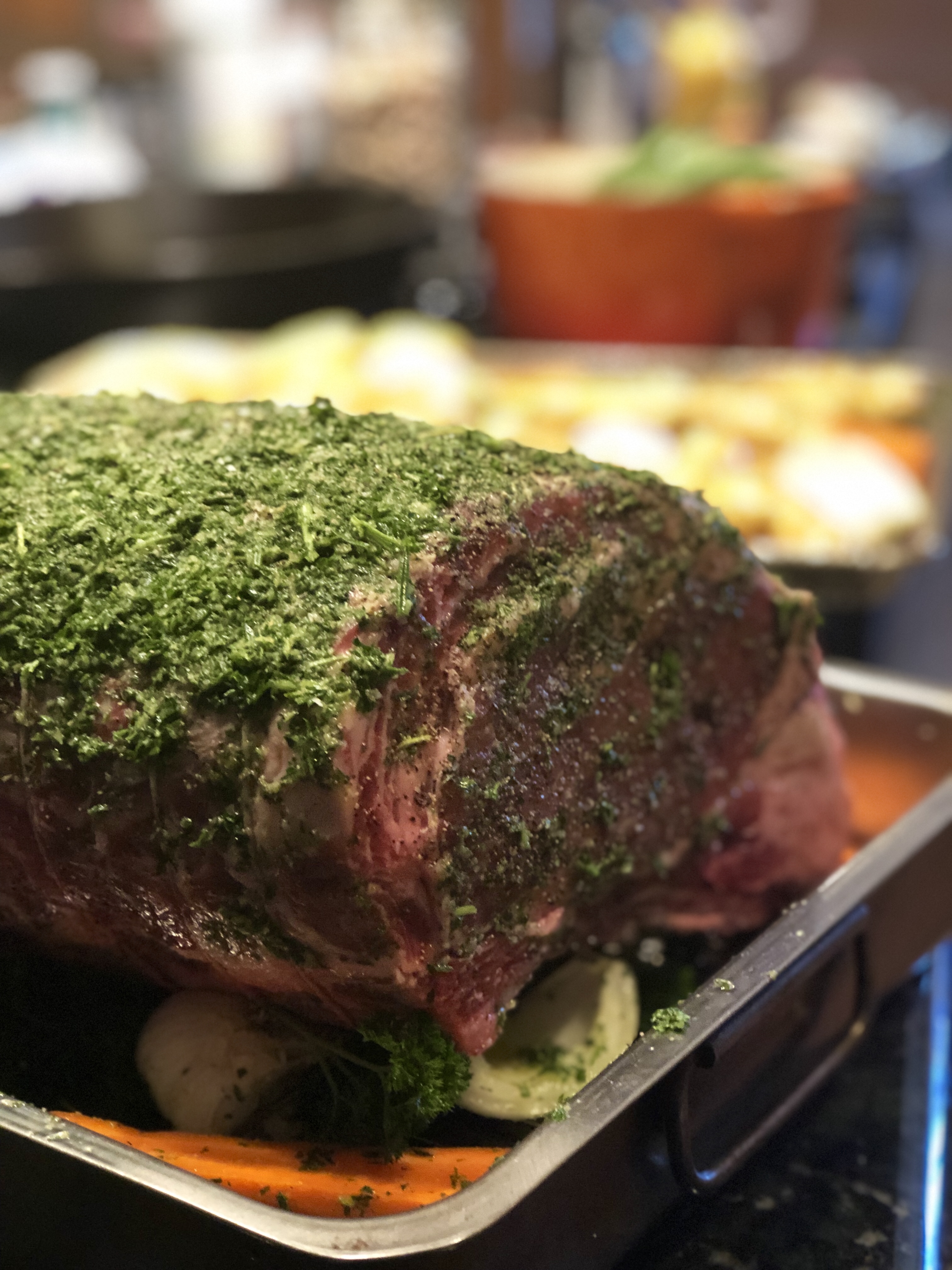
A true prime rib that is labeled USDA Certified Prime, is heavily marbled with a generous amount of fat. These cuts are usually reserved for top restaurants and are hard to come by. It may be better to seek out a fine aged prime rib. Aged beef is similarly hard to find in the supermarket, but you’ll find aged prime rib and other cuts for sale online that come right to your door. But ask your butcher first!
The typical prime rib serving size is around 10 ounces per person; a roast weighing 7-7½ pounds should serve 11 or 12 people.
You’ll Need:
8 ribs – prime rib of beef. Center cut, chine bone removed. (make sure to give your butcher a friendly reminder to remove the chine bone)
1 cup fresh Italian parsley leaves plus 1 large bunch
1/4 cup fresh thyme leaves
1/8 cup fresh rosemary leaves
1/4 cup fresh oregano leaves
1/4 cup fresh marjoram leaves
1/4 cup good quality olive oil
6 cloves of garlic, peeled and root removed
3 whole heads garlic, 1/4 cut off the top exposing cloves, skin and root left intact.
3 large shallots, cleaned roots removed
1 large onion, cleaned, cut into quarters
1 carrot, cleaned and sliced lengthwise
2 ribs of celery, cleaned cut in half
1/2 pound of unsalted butter, cut into pieces and kept cold
2 cups good quality Pinot Noir wine
Preferably Maldon salt or large flat crystal salt
Fresh ground black pepper
Here’s How:
Preheat oven to 475’F degrees. Clean and pick the leaves of the fresh herbs, reserving the stems. Except the extra bundle of parsley.
Prepare a large roasting pan with organic non-stick cooking spray. Check to make sure the roast will fit. Spray a cookie cooling rack with non-stick cooking spray, and lower into the roasting pan. Build a bed for the roast to lay on with the bundle of parsley, and all the stems left over from the herbs on top of the cookie rack. Add the carrot, onions quarters, the 3 whole heads of garlic on the side, and the celery ribs. Spritz everything with a good drizzle of olive oil and sprinkle of salt and pepper. Set aside.
Pat the roast dry with paper towel. Season the roast generously with salt and fresh ground pepper by hand massaging it in ; on all sides. Set aside. In the bowl of your food processor, add 4 cloves of garlic, all the fresh herbs except the extra bundle of parsley, add 2 shallots and pulse to small mince.
Add salt and pepper and cold butter, pulse to combine well- make a paste.
Place roast, horizontally with the fat side up, in the roasting pan. Smother the roast with the butter mixture paying extra attention to the sides of the roast. Add 1 cup of beef stock to the bottom of the roasting and roast for 1 1/2-2 hours (20 minutes per pound), for rare –or until internal temperature reaches your desired temp ranges. ( see roasting notes below ) Bathing with juices from the bottom of the roasting pan every twenty minutes, without fail!
Start with high heat oven of 425’F Degrees and reduce temperature to 325’F Degrees after about 15 minutes of oven time.
When roast reaches your desired internal temperature, remove from the oven and allow to rest a minimum 10-20 minutes.
Keep in mind the internal portion of the roast will continue to cook, make sure to remove it from the oven ten minutes prior to your desired internal temperature. See below for important roasting notes.
Variation: To serve roast without bone, use a sharp knife and cut between the bone and the flesh. With your slightly angled knife, saw towards the bone, carving slowly–keep following the bone to the bottom where it can be completely removed.
Chef Notes:
Use your meat thermometer about a half hour before the expected end of the roasting time. Make sure to insert it in the thickest part of the meat, not touching the fat or the bone.
When the internal temperature reaches 120° F Degrees pull it out of the oven, and cover with foil.
Allow the roast sit for twenty minutes.
While resting the roast will continue to cook, reaching a temperature of about 125° F Degrees to 130° F Degrees. This is called the endo-thermic reaction. Cooking from the inside out.
A nice resting period allows the juices and flavors to permeate back into the roast instead of all over the cutting board!
Rare measures in at 120° to 125° with a bright red center that grows slightly pinkish towards the exterior.
Medium rare measures between 130° F Degrees to 135° F Degrees and are characterized by the extremely pink center portion that grows brown towards the exterior.
Medium meats have a light pink center, brown outer portions and readings of about 140°F Degrees to 145°F Degrees.
Medium well is not pink at all, and is achieved at 150° F Degrees to 155° F Degrees.
Well done is at 160° F Degrees and above and is characterized by a uniform brown color.
Cover any exposed bones with a little oil and foil.
Red Wine Reduction
While roast is resting, strain drippings from the pan. Defat and add the remaining juices into a medium saucepan with wine, remaining garlic cloves, remaining chopped shallot.
Bring to a boil, and cook stirring occasionally until the liquid is reduced to 2/3’s of a cup, about 10 -15 minutes. Adjust heat as necessary to avoid boiling over or burning.
When liquid is reduced, remove from heat and whisk in remaining cold butter, 2 or 3 pieces at a time, waiting until pieces are melted before adding more. Season with salt and pepper.
Cover to keep warm and set aside. To serve beef cut between rib bones and serve bone in.
Serve sauce at the table on the side.

Wow!
LikeLike